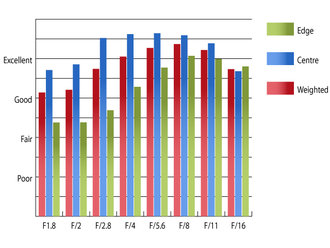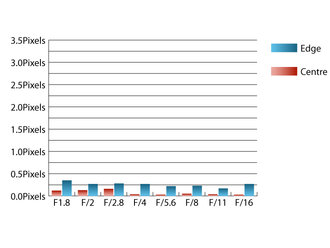Nikon AF-S Nikkor 85mm f/1.8G
Nikon AF-S Nikkor 85mm f/1.8G Performance
Sharpness in the centre of the image is already very good at f/1.8, and although the clarity drops off quite significantly towards the edges, this shouldn't be to much of an issue for portraits and similar photography at wide apertures. As is the case with many lenses, stopping down improves clarity across the frame. Peak sharpness across the frame is achieved between f/5.6 and f/8 where sharpness in the centre is outstanding and excellent towards thee edges of the frame. Resolution @ 85mm | How to read our chartsThe blue column represents readings from the centre of the picture frame at the various apertures and the green is from the edges. Averaging them out gives the red weighted column.The scale on the left side is an indication of actual image resolution. The taller the column, the better the lens performance. Simple. For this review, the lens was tested on a Nikon D700 using Imatest. |
Even though this lens contains no exotic low-dispersion glass in its design, chromatic aberration levels are very low, peaking at 0.35 pixel widths towards the edges of the frame at f/1.8, which should barely be noticeable.
 Chromatic aberration @ 85mm | How to read our chartsChromatic aberration is the lens' inability to focus on the sensor or film all colours of visible light at the same point. Severe chromatic aberration gives a noticeable fringing or a halo effect around sharp edges within the picture. It can be cured in software.Apochromatic lenses have special lens elements (aspheric, extra-low dispersion etc) to minimize the problem, hence they usually cost more. For this review, the lens was tested on a Nikon D700 using Imatest. |
Falloff of illumination towards the corners is quite pronounced at maximum aperture with the corners being over two stops darker than the image centre. Stopping down improves this and visually uniform illumination is achieved by f/4.
Only 0.577% pincushion distortion could be detected by Imatest, which is a very mild level of distortion. This low level shouldn't affect day to day images, but if absolutely straight lines are required, the distortion is relatively easy to correct, as it is uniform across the frame.
Excellent price for performance when compared to the Nikon's legendary 1.4G ($1900 approx). Makes me wonder why the heck Photodo gave this lense the SAME value for money as the 85mm 1.4G?
Value for money for this 85mm 1.8G ($600 approx) is clearly 4.5 to 5 stars.
Value for money for this 85mm 1.8G ($600 approx) is clearly 4.5 to 5 stars.
Add your message
Login required
Please login here or if you've not registered, you can register here. Registering is safe, quick and free.
Please login here or if you've not registered, you can register here. Registering is safe, quick and free.
photodo Stats
1102 lenses
428 MTF tests
74 in-depth photodo reviews
100+ users join each day
Help the lens community by reviewing or rating a lens today via our lens search
428 MTF tests
74 in-depth photodo reviews
100+ users join each day
Help the lens community by reviewing or rating a lens today via our lens search
Latest Lens Reviews
- Chinon 28mm f/2.8 Vintage Lens Review
- Canon EF 70-200mm f/4L IS II USM Lens Review
- Samyang AF 85mm f/1.4 EF Review
- Sigma 70mm f/2.8 DG Macro Art Review
- Samyang AF 24mm f/2.8 FE Review
- Meike 50mm f/1.7 Review
- Tamron 70-210mm f/4 Di VC USD Review
- Lensbaby Burnside 35mm f/2.8 Review
- Asahi Super Takumar 50mm f/1.4 Review
- Asahi Super-Multi-Coated Takumar 135mm f/3.5 Review
